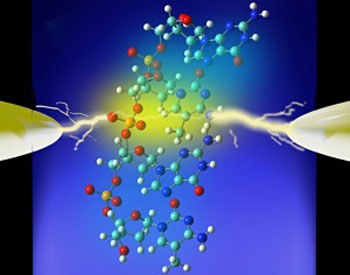| Aug 15, 2011 |
DNA readers: Cracking the epigenetic code
|
|
(Nanowerk News) Decoding some of the subtler information encoded in our DNA could soon become a high-throughput process, a team of researchers in Japan have shown. Masateru Taniguchi and colleagues at Osaka University have shown that DNA-borne chemical markers, which play a key role in gene expression, can be detected electrically using nanoscale electrodes ("Electrical Detection of Single Methylcytosines in a DNA Oligomer").
|
|
The team's technology is a step toward understanding the meaning of some of the molecular modifiers that nature uses to annotate DNA strands. These modifiers, also known as epigenetic markers, alter over time and are thought to play a key role in processes ranging from embryo development to aging and disease. But just how the markers work, and what different markers mean, remains to be unraveled.
|
 |
| As DNA is passed through a nanoscale gap between two electrodes, a measurable current is generated allowing the detection of DNA markers.
|
|
Deciphering the epigenetic code is a massive mapping exercise, but will provide important information on how epigenetic markers differ among cell types and between healthy and sick individuals. Actually detecting the markers, however, has proved difficult. One of the most common markers is an individual methyl group, which consists of a single carbon atom and three hydrogen atoms, and its detection has previously required the attachment of additional chemical labels. "But such an approach is troublesome and takes a lot of time," says Taniguchi. The ability to detect markers such as methyl groups directly would therefore open up immense opportunities for epigenetic research.
|
|
Taniguchi and his colleagues explored the possibility of direct marker detection by analyzing a small strip of DNA as it passes between two electrodes positioned just a nanometer apart (see image). An electrical current flows as the DNA squeezes between the electrodes, and the size of the current depends on the chemical make-up of the DNA within the gap. This allows any molecular marker on the DNA, including individual methyl groups, to be detected electrically.
|
|
The key issue for turning the technology into a practical, rapid DNA-reading device is achieving precise control of the movement of the DNA strand through the electrode nanopore. "Recently, we have theoretically proposed a way to control DNA strand flow using a gate," Taniguchi explains. "We are now developing a gating nanopore device as a proof-of-principle demonstration of this electrical gating scheme."
|

